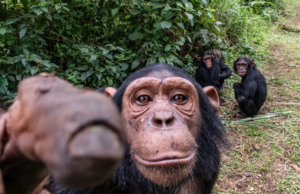A day with a female wild chimpanzee and her 5-year-old baby

By Serge K. Soiret, GAP correspondent in West Africa, from Ivory Coast
We leave our camp to the dense forest of Taï Park very early in the morning to go finding the female chimpanzee and her baby that we have been following for months*. At about 5:30am we arrive near the tree the mother chimpanzee and her 5-year-old male baby had built the nest for them to spend the night.
The first movements of them awaking started at about 6:10 am. The nest is built in a 10-meter height and 30 centimeters wide tree located 20 meters far from a fruit tree – species Ficus macrosperma -, which guarantees breakfast on the morning. From May to August there is shortage of ripe fruit for chimpanzees in Taï forest. About fifteen minutes after they awake, the mother gets out the nest with her son and they go to the Ficus tree.
We wait under the fruit tree during 1 hour and 25 minutes, the time they took to eat. Finally she goes down the Ficus with her baby on the back and he puts his foot on the ground for the first time that day. The weather on the forest is cloudy, with a little bit of rain. A few minutes later, she rises in a tree with her baby and waits until the rain stops. After that she goes down the tree and and walks on the forest. She does not miss the opportunity to eat termites on her way.
Along the way, the baby walks often by her side, on her back or hanging on under the stomach. At 10:35 am, they rest in a clearing in the forest. Far away it seems to have a palm tree (Elaeis guineensis) and she tries to reach it. She climbs on a tree next her and reaches the palm tree jumping from one branch to another. She arrives at the top of the palm tree, where she settles down with her baby to eat the inferior a soft part of the twigs. The day is marked by walking and stops to eat leaves.
After more than eight hours of walking in the forest in all the possible directions, she returns to the Ficus, where she found out another female with her 6-month-old baby hung under the belly. They spend more than two hours together in the tree, until the female goes down with her son **.
After a short walk, she stops and observes the horizon from the top of the trees. She rises on a tree, sits and watches the top of other trees. She finally arrives in a tree and sits down. Her baby is never far from her. She starts to catch the branches of the tree and put them together to build a nest. It is about 5:30pm. After they settle on the nest, we go back to the camp. Tomorrow we will go again to the forest at 5:00 am, to follow their day after they wake up.
*In this area chimpanzees are very used to human presence and that is the reason why a very close observation is possible. The researchers have the support of local guides, who end up protecting chimpanzees from poachers.
** These chimpanzees belong to the same group, but at this time of the year they tend to be more dispersed, due to the lack of fruit. Apart from that, this specific female enjoys to spend more time alone with her son, according to the observations made on the field work.

 Español
Español
 Português
Português








